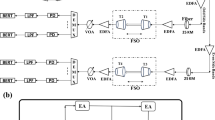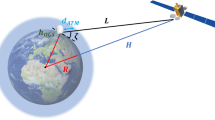Abstract
In Brazil, the 3625–4200 MHz frequency band (C-band) is widely used by TV receive-only (TVRO) application in the fixed satellite service (FSS). The 3400–3600 MHz adjacent band can be used by International Mobile Telecommunications (IMT) systems, but many low noise block downconverters (LNB) of TVRO sold in Brazil have not a C-band filter. Thus, it is likely that the low cost LNB used in TVRO receivers would be overloaded by the IMT-systems emissions within the LNB wideband receiver, even the IMT stations operating accordingly to international standards. This paper shows that both systems can coexist harmoniously depending on the characteristics of the IMT system and on the FSS receiver specifications.







Similar content being viewed by others
Notes
This value is used in several interference studies, e.g. [28,29,30,31]. Besides, in a recent analysis using Seamcat, Anatel (the Telecommunications Regulatory Body of Brazil) analyzed the harmful interference caused by a LTE base station (operating at the 700 MHz frequency band) in TV receivers. Simulations using Seamcat showed a probability of harmful interference of about 5% for an LTE base station with equivalent radiated power of 54 dBm [29]. Nevertheless, by the time this paper is being written, no critical interference from the recently deployed LTE-700 MHz network to the broadcasting receivers was detected, following the same pattern experience of other countries [32].
References
Cisco. (2016). Cisco Visual Networking Index: Global mobile data traffic forecast update, 2015–2020. White paper, Cisco.
ITU. (2015). Report ITU-R M.2370-0: IMT traffic estimates for the years 2020 to 2030. Technical report, ITU-R.
LS telcom. (2014). Mobile spectrum requirements estimate: Getting the inputs right. Technical report, LS telcom.
Russian Federation. (2012). Document 5D/118-E: Future IMT spectrum requirements assessment for the Russian Federation. Technical report, ITU-R.
Fernandes, L. C., Linhares, A., & Ferreira, L. R. N. (2017). Spectrum forecasting for IMT-advanced. Telecommunication Systems. doi:10.1007/s11235-017-0276-5.
Anatel. (2010). Resolution no 537. Feb 2010 [In Portuguese: Resolução no 537, de 17 de fevereiro de 2010].
ITU. (2011). Report ITU-R S.2199-0: Studies on compatibility of broadband wireless access (BWA) systems and fixed-satellite service (FSS) networks in the 3400–4200 MHz band. Retrived from https://www.itu.int/dms_pub/itu-r/opb/rep/R-REP-S.2199-2010-PDF-E.pdf.
ITU. (2003). Recommendation ITU-R M.1634-0: Interference protection of terrestrial mobile sharing systems using Monte Carlo simulation with application to frequency sharing.
ITU. (2002). Report ITU-R SM.2028-1: Monte Carlo simulation methodology for the use in sharing and compatibility studies between different radio services or systems.
CEPT. (2016). ECC report 252: SEAMCAT handbook, 2nd edn.
ITU. (2015). Report ITU-R S.2368-0: Sharing studies between International Mobile Telecommunication-Advanced systems and geostationary satellite networks in the fixed-satellite service in the 3400–4200 MHz and 4500–4800 MHz frequency bands in the WRC study cycle leading to WRC-15.
WiMAX Forum. (2007). Compatibility of services using WiMAX technology with satellite services in the 2.3–2.7 GHz and 3.3–3.8 GHz bands.
ITU. (2013). Report ITU-R M.2292-0: Characteristics of terrestrial IMT-advanced systems for frequency sharing/interference analyses.
3GPP. (2016). 3GPP TS 36.104 v13.2.0.
ITU. (2014). Report ITU-R M.2324-0: Sharing studies between potential International Mobile Telecommunication systems and aeronautical mobile telemetry systems in the frequency band 1429–1535 MHz.
ECC. (2015). ECC report 227: Compatibility studies for mobile/fixed communication networks (MFCN) supplemental downlink (SDL) operating in the 1452–1492 MHz band.
3GPP. (2016). 3GPP TS 36.101 v14.0.0.
ITU. (2010). Recommendation ITU-R S.465-6: Reference radiation pattern for earth station antennas in the fixed-satellite service for use in coordination and interference assessment in the frequency range from 2 to 31 GHz.
Anatel. (2013). Report of the 3.5 GHz workgroup (GT 3.5 GHz).
ITU. (2009). Report ITU-R M.2135-1: Guidelines for evaluation of radio interference technologies for IMT-advanced.
Walden, M. C., & Rowsell, F. J. (2005). Urban propagation measurements and statistical path loss model at 3.5 GHz. In IEEE antennas and propagation society international symposium, 2005.
ITU. (2015). Recommendation ITU-R P.452-16: Prediction procedure for the evaluation of interference between stations on the surface of the Earth at frequencies above about 0.1 GHz.
Nwawelu, U. N., Nzeako, A. N., & Ahaneku, M. A. (2012). The limitations of campus wireless networks: A case study of University of Nigeria, Nsukka [Lionet]. International Journal of Networks and Communications, 2(5), 112–122.
Yamada, W., Sasaki, M., Kita, N., Sugiyama, T. New prediction method using visibility factor for path loss between mobile terminals in residential area in microwave band.
Rodriguez, I., Nguyen, H. C., Jørgensen, N. T. K., Sørensen, T. B., Elling, J., Gentsch, M. B., & Mogensen, P. (2013). Path loss validation for urban micro cell scenarios at 3.5 GHz compared to 1.9 GHz. In 2013 IEEE global communications conference (GLOBECOM), Dec. 2013 (pp. 3942–3947).
ITU. (2008). Recommendation ITU-R SM.337-6: Frequency and distance separations.
Ancans, G., Stankevicius, E., Bobrovs, V., & Paulikas, S.: Evaluation of LTE 700 and DVB-T electromagnetic compatibility in adjacent frequency bands. In Progress in electromagnetics research symposium proceedings.
Cheng, Y., Wang, Y., Yun, H., & Lee, I. (2014). Interference impact of LTE on mobile WiMAX in TV white spaces. International Journal of Information and Electronics Engineering, 4(5), 403–408.
CEPT. (2014). ECC report 207: Adjacent band co-existence of SRDs in the band 863–870 MHz in light of the LTE usage below 862 MHz.
Anatel. (2014). Technical Note no 07/ORER/2014: Estimates of the percentage of Brazilian households that will need to adopt an additional filter in TV reception, June 2014 [In Portuguese: Nota Técnica no 07/ORER/2014: Estudo para estimativa do percentual de domicílios brasileiros para os quais será necessária adoção de filtro adicional na recepção de TV, de 17 de junho de 2014].
Watson, J. (2014). When it comes to interference, you can’t beat real world experience. Policy Tracker, 2014.
Citel. (2016). Working document toward a draft recommendation. CCP.II-RADIO/doc. 4202/16 rev.1: Frequency arrangements for the terrestrial componente of IMT in the bands 3300–3400 MHz, 3400–3600 MHz and 3600–3700 MHz.
Author information
Authors and Affiliations
Corresponding author
Additional information
Disclaimer
This paper reflects the authors’ own opinion and do not necessarily reflects the official policy or position of Anatel.
Rights and permissions
About this article
Cite this article
Fernandes, L.C., Linhares, A. Coexistence conditions of LTE-advanced at 3400–3600 MHz with TVRO at 3625–4200 MHz in Brazil. Wireless Netw 25, 105–115 (2019). https://doi.org/10.1007/s11276-017-1544-8
Published:
Issue Date:
DOI: https://doi.org/10.1007/s11276-017-1544-8




